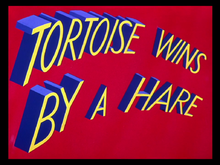Tortoise Wins by a Hare
| Tortoise Wins by a Hare | |
|---|---|
 Title card | |
| Directed by | Robert Clampett |
| Story by | Warren Foster |
| Produced by | Leon Schlesinger |
| Music by | Carl W. Stalling |
| Animation by | Bob McKimson |
| Color process | Technicolor |
Production company | |
| Distributed by | Warner Bros. Pictures The Vitaphone Corporation |
Release date |
|
Running time | 7:44 |
| Country | United States |
| Language | English |
Tortoise Wins by a Hare is a Merrie Melodies cartoon released on February 20, 1943, and directed by Bob Clampett.[1] It stars Bugs Bunny and Cecil Turtle.[2] It is a sequel to 1941's Tortoise Beats Hare, with footage from said cartoon briefly shown at the beginning. It is also the first short to feature Robert McKimson's design of Bugs Bunny.
Plot
[edit]Bugs Bunny, determined to discern the true secret behind Cecil Turtle's previous victory, embarks on a quest for knowledge. Disguising himself as an elderly gentleman, Bugs confronts Cecil at his residence. Despite the turtle's immediate recognition of Bugs' ruse, he humorously entertains the inquiry, attributing his triumph to a fictitious "air-flow chassis" blueprint purportedly enhancing his aerodynamic efficiency. Cecil further disparages rabbits as intellectually deficient, exacerbating Bugs' frustration.
Undeterred by Cecil's taunts, Bugs endeavors to emulate his opponent's alleged advantage by constructing a similar shell for himself. Concurrently, a betting frenzy ensues among the rabbit community, pledging unwavering support for Bugs' anticipated victory. However, confusion ensues during the race as Bugs assumes an early lead, prompting misguided attacks from the rabbit mob, mistakenly identifying Bugs as Cecil due to his new attire. Cecil exacerbates the chaos by masquerading as a rabbit, deceiving the mob and further hindering Bugs' progress.
Despite these obstacles, Bugs demonstrates resilience and nearly secures victory until the rabbit mob intervenes, stalling his momentum and facilitating Cecil's triumph. Devastated by the unforeseen turn of events and the realization of inadvertently aiding Cecil's victory once again, Bugs relinquishes his facade, revealing his true identity. In utter shock at what they’ve done, the mobsters all shoot themselves in the head.
Production crew
[edit]- Supervision: Robert Clampett
- Story: Warren Foster
- Animation: Robert McKimson (As Bob McKimson)
- Additional Animation: Rod Scribner, Sid Sutherland, Virgil Ross, Thomas McKimson
- Character Designs and Backgrounds: Robert McKimson, Michael Sasanoff
- Film Editor: Treg Brown
- Musical Direction: Carl W. Stalling
- Orchestration: Milt Franklyn
- Producer: Leon Schlesinger
Voice actors
[edit]- Mel Blanc as Bugs Bunny, Cecil Turtle, Narrators, Rabbit Bookie, Rabbit Thugs and Mrs. Turtle
- Kent Rogers as Rabbit with Telescope
- Michael Maltese as Various Rabbit Thugs
- Tedd Pierce as Various Rabbit Thugs
Analysis
[edit]The animated short contains wartime references. Bugs displays "A" and "C" ration cards. He claims he has a secret weapon. A Japanese cruiser is mentioned in a newspaper headline, as is the accurate prediction of Adolf Hitler's suicide two years later. A chorus of turtles sing "He did it before and he can do it again".[3]
Nichola Dobson mentions the short as an example of both Bob Clampett's attention to detail and of the fast pace of his work.[4]
The suicide gag at the end is normally edited out of television broadcasts, fading out just as the rabbits say, "NOW he tells us."
Reception
[edit]Animation historian Jerry Beck writes, "One of the things that most fans of director Bob Clampett's cartoons relish is that he would do almost anything to create a funny cartoon. That meant he would violate established character personality traits and traditional story points to get laughs. Here, he not only shreds the Aesop fable and Disney's 1935 short The Tortoise and the Hare but also Tex Avery's send-up of this famous race. The results are priceless... Only Clampett could twist his characters into such pretzels, and put them through the emotional wringer, with such hilarious results."[5]
Home media
[edit]This short was released, uncut and uncensored, on Looney Tunes Golden Collection: Volume 1 and Looney Tunes Platinum Collection: Volume 2.
Sources
[edit]- Dobson, Nichola (2010). "Clampett, Bob". The A to Z of Animation and Cartoons . Scarecrow Press. ISBN 978-1461664024.
- Shull, Michael S.; Wilt, David E. (2004). "Filmography 1943". Doing Their Bit: Wartime American Animated Short Films, 1939-1945. McFarland & Company. ISBN 978-0786481699.
See also
[edit]References
[edit]- ^ Beck, Jerry; Friedwald, Will (1989). Looney Tunes and Merrie Melodies: A Complete Illustrated Guide to the Warner Bros. Cartoons. Henry Holt and Co. p. 138. ISBN 0-8050-0894-2.
- ^ Lenburg, Jeff (1999). The Encyclopedia of Animated Cartoons. Checkmark Books. pp. 60–61. ISBN 0-8160-3831-7. Retrieved 6 June 2020.
- ^ Shull, Wilt (2004), p. 159
- ^ Dobson (2010), p. 44
- ^ Beck, Jerry, ed. (2020). The 100 Greatest Looney Tunes Cartoons. Insight Editions. p. 191. ISBN 978-1-64722-137-9.
External links
[edit]- 1943 films
- 1943 short films
- 1943 animated films
- American track and field films
- Merrie Melodies short films
- Films about organized crime in the United States
- Films directed by Bob Clampett
- Self-reflexive films
- Films based on the Tortoise and the Hare
- Films scored by Carl Stalling
- Films produced by Leon Schlesinger
- Bugs Bunny films
- 1940s Warner Bros. animated short films
- 1940s English-language films
- Films with screenplays by Warren Foster
- English-language short films
